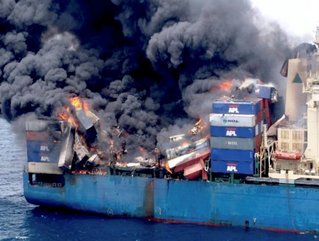EVs pose growing fire risk to supply chain, says Allianz

Lithium-ion (li-ion) batteries are posing an increasing fire threat to shipping and warehousing operations, marine risk experts say.
Allianz Global Corporate & Specialty (AGCS) marine risk consultants warns that, with the rise of electric vehicles (EVs), li-ion batteries pose a growing risk because of the greater volume stored in warehouses and shipped on vessels as cargo or already installed in new EVs.
The biggest threat posed by li-ion batteries are so-called ‘thermal runaway events’, which is when the li-ion cell enters an uncontrollable, self-heating state. This result in the ejection of gas and shrapnel at extremely high temperatures. Thermal events can be caused by poorly constructed batteries, overcharging or the use of an incorrect charging device.
Thermal runaway events affect all configurations of li-ion batteries used in vehicles. These include battery electric vehicles (BEV), hybrid electric vehicles (HEV) and plug-in hybrid electric vehicle, which split the difference between BEVs and HEVs.
The report says that a problem with determining the cause of on-ship fires – also known as ‘thermal runaway events’ – is that they burn at extreme temperatures, and for days at a time,meaning little or no trace of evidence remains to be examined.
Prevention key to stopping li-ion supply chain fires
“Early detection is rarely possible due to a shortage of manpower and a lack of adequate firefighting capabilities on board,” says Randy Lund, Senior Marine Risk Consultant at Allianz Global Corporate & Specialty, and a co-author of the report. “So the primary focus must be on prevention.”
To this end, Allianz is offered recommendations to manufacturers, shippers, transporters – as well as to insurance underwriters – based on information and testing currently available.
“This information is provided to assist in determining the risks associated with shipments of li-ion batteries as standalone cargo and when installed within a vehicle,” says Lund.
One of the recommendations is that li-ion cells and batteries must be offered for transport at a state of charge (SoC) not exceeding 30% of their rated capacity.
It also urges shipping lines to provide their seafarers with enhanced training and awareness protocols on li-ion firefighting techniques
Allianz is also pressing for shipping lines to instal early detection systems, including watch-keeping and fire rounds, thermal scanners, gas detectors, heat and smoke detectors and CCTV cameras.
Other recommendations include:
- Review safety-data sheet or information card describing preventive actions in case of an accident
- All EVs should display clear and precise identification on the windshield detailing the battery type (BEV, PHEV or HEV)
- No charging of EVs during passage
- EVs must be properly secured to prevent any shifting during transport
Warehouse li-ion storage guidance
The recommendations also extend to land-based storage of li-ion batteries, in warehouses. These include:
- Observe manufacturer’s instructions included on technical
- product data sheets
- Protect battery poles from short circuit events
- Do not expose to heat sources, including direct sunlight
- Space batteries a minimum of 3 metres away from other combustible materials if no automatic extinguishing equipment is available
- Floor-stack li-ion batteries only in designated areas with limited stack heights, footprints and separation distances
- Ensure damaged batteries are removed immediately from storage and production areas.
Lund adds: “With quickly evolving technology and a lack of consistent regulation, evaluation of the risks of li-ion battery usage will need to develop over time.
“If the maritime industry is to improve its incident record related to the transport of these battery types, all parties involved in the supply chain must understand the hazards involved, the most common causes and problems associated with transporting in commerce.
“All parties in the supply chain must understand the hazards. The regulations, both domestic and international, can only be effective if they are communicated and enforced.
“Only through a concerted effort by stakeholders in the supply chain can we hope to reduce the rate of incidents.”
- Coface Provides Visibility and Suppliers' Financial HealthTechnology
- Coface Protects Firms From Supplier Risks in Volatile WorldTechnology
- Surge in Container Ship Orders 'Will Ease Red Sea Crisis'Supply Chain Risk Management
- SAP: US, UK & India elections 'will impact supply chain'Technology






